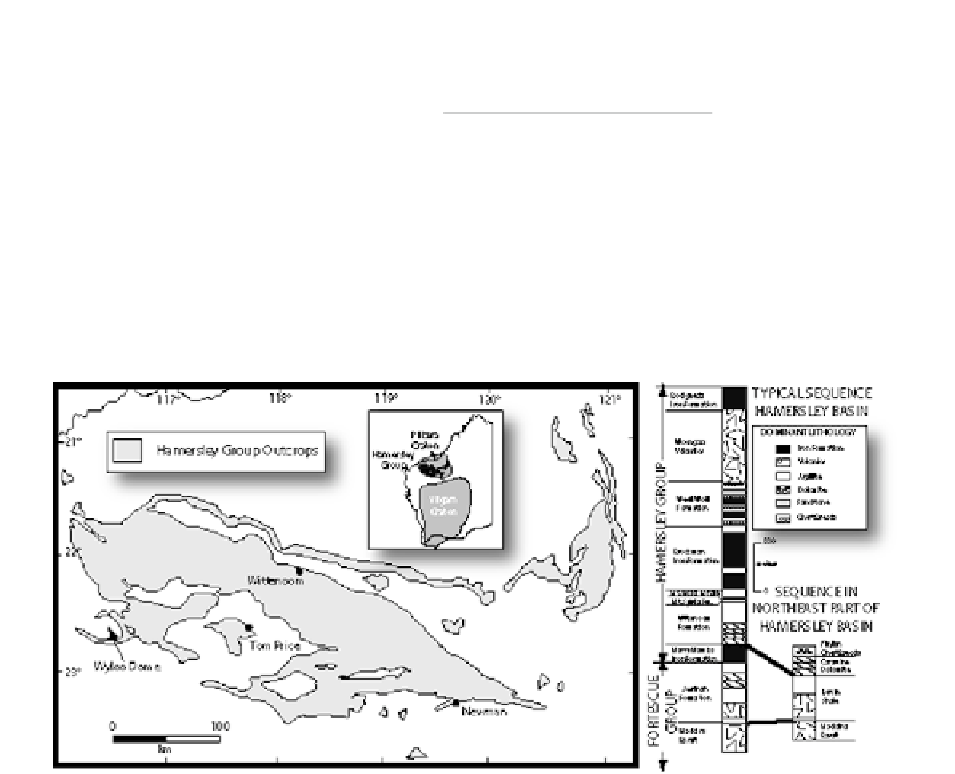Geology Reference
In-Depth Information
Table 15.1
Tidal sedimentary structures
Foreset
bundles
Bim-Bip Palcurr.
H-bone. X-bed.
Tidal bedding
Modified ripples
Rhythmic bedding
Elatina (0.6 Ga)
Yes
Yes
Yes
No
Yes
Yes
Big Cwood (0.9 Ga)
No
No
Yes
Yes
Yes
Yes
Uncomp. (1.7 Ga)
No
No
Yes
No
No
Yes
Ortega (1.7 Ga)
Yes
Yes
Yes
No
No
No
U Mt Guide (1.8 Ga)
No
No
No
Yes
No
Yes
Waterberg (1.8 Ga)
Yes
No
Yes
No
No
No
Pokegama (~1.9 Ga)
Yes
Yes
Yes
No
Yes
No
Witsrand (~2.9 Ga)
Yes
Yes
Yes
Yes
Yes
Yes
Moodies (3.25 Ga)
Yes
Yes?
Yes
No
Yes
Yes
Fig. 15.21
Geological map showing the distribution of the Hamersley Group and generalized stratigraphic column of the Fortescue
and Hamersley groups, Pilbara Craton, Western Australia (Adapted from Trendall
1983
)
15.5
Preservation Potential and
Sequence Stratigraphy
bed near the top of a tidal channel cycle in the Dycedale
Syncline. This structure is lens-shaped with dimen-
sions of about 3 cm by 2.5 cm and is composed of
alternating mm-thick sandstone, and sub-mm-thick
carbon-rich laminae. Such roll-over microbial mats are
not uncommon on modern tidal flats (Noffke et al.
2001
) and are produced by bottom currents that over-
fold desiccated microbial mats. In thin-section, the
MISS samples from the Moodies Group reveal a wavy-
crinkly pattern of dark, opaque laminae characteristic
of ancient microbial mats in sandstones (Noffke et al.
2006
). The dark, opaque laminae are between 50 and
500 Pm thick and alternate with mm-thick quartz sand
laminae. This laminated pattern is also very charac-
teristic of modern, unlithified tidal sand deposits that
include microbial mat layers.
An analysis of the stratigraphic location and sequence
stratigraphic interpretation of the Precambrian tidal
facies reviewed in this chapter permits conclusions to
be drawn concerning factors that promoted their pres-
ervation in the rock record. Tidal-shelf and tidal-flat
facies in the Moodies Group of the Eureka Syncline
are developed above braided-alluvial deposits and
are capped by a banded iron-formation (Fig.
15.24
).
BIF's developed in predominantly siliciclastic succes-
sions have been compared with Holocene pelagic
deposits that are concentrated in environments not
diluted with siliciclastic sediment (Eriksson
1983
).
Thus, the BIF in the Moodies Group is interpreted as a




































































